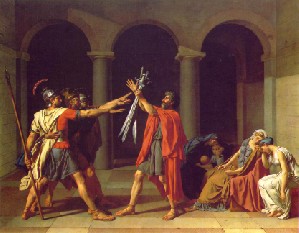Art Terms and Techniques
John Haberin New York City
A Brief Dictionary
For further art education, take a free docent tour—or get fluent in artspeak and "martspeak." Besides, your favorite Web art critic rather easily blends into fiction.
Abstract Expressionism. Art composed during summers in the Hamptons when it's too rainy for the beach and Lee Krasner has a lock on the liquor cabinet. See Action Painting.
|

Figure 1. Jacques-Louis David and the birth of Neoclassicism. In this revolutionary scene, three men dressed for a toga party rush to the aid of an old man about to juggle three long swords. Two women doze off at the sight of male posturing, important painting, and the bare architecture, whose arches symbolize the Trinity, the Three Fates, the Three Stooges, and the old Brooklyn Dodger outfield. Fortunately, the lighting sinks two-thirds of them in shadow. David vividly highlights the soldiers from the rear, emphasizing the painting's innovative theme: never turn your back on a man with three sharp swords. The plastic power (© Tupperware Collection, 1785) and expressive drama of the Horatii are powerfully conveyed, as the second soldier has three legs, the third but one, and the left arm of the first is double-jointed. Their right arms have since been unscrewed and preserved in the Smithsonian. The return to a Caravaggiesque style invokes those long-gone days when Horatii were men, painting was painting, and a good cigar was a smoke. |
Acrylic. See Home Depot.
Action painting. Art composed during food fights at the Cedar Bar. See Abstract Expressionism.
Art. See Artist.
Artist. See Art.
Avant-garde. A serious threat to public morals (obsolete).
Baroque (also known as B-r-r-oke). The condition of all the artists I know. Initiated in Rome during a traffic jam, it replaced the idealized poses of the Renaissance with dead bodies that complain less often about their likeness.
Blue Rider. Either parent after two hours of "Are we there yet?" Its abstract canvases incorporate colorful horses leaping over mountains, to keep the kids from replaying "Sponge Bob Square Pants" yet again.
Classicism. A movement reflecting the explosion of freedom under the Reign of Terror and the Napoleonic empire. Begun when J.-L. David (Figure 1) placed his own head on the guillotine in the interest of public safety, it was characterized by form, proportions, and utter lack of humor.
Contrapposto. The representation of nude young men turned suggestively toward Leonardo and Michelangelo.
Critical theory. The theory that I'm a critic, she's an artist, and you're not. Well after Postmodernism and repeated visits to this Web site, it remains controversial.
Cubism. (1) A movement associated with Pablo Picasso, whose titanic ego attracts the longest museum lines ever to MoMA. (2) The rooms most often skipped by visitors to MoMA. (3) Art between Picasso's shocking pink period, his Technicolor period, and lunch.
Dada. (1) A movement begun by Marcel Duchamp at 18 months old. Incorporating anything into the work except art, it served as a major influence on public toilets and Surrealism. (2) The opposite of feminism. See Mama.
Etching. Prints from plates prepared with acid rather than crack. Often used in "Come up and see my etchings."
Hudson River School. See Dead salmon.
Iconography. The incorporation of obscure symbols into otherwise unrealistic images, like the hidden text here telling your boss you're surfing the Web instead of working.
Impressionism. (1) Early Video featuring impressions of George Bush singing along with Elvis. Started when Claude Monet captured a sunrise without noticing the rain all over his glasses, it made use of colors unmixed with soda or tonic. (2) Any art that makes an impression. See Etching.
Irony. Well, you're reading this, aren't you?
Islamic art. Art created by immediate threats to democracy. Best displayed covered by the American flag or without a lawyer present.
M.F.A.. Mean f'in' artist. See B.F.A..
Minimalism. (1) Art patterned after Manhattan interiors in the Times "Style" section. (2) Art that makes the least effort possible while still earning an M.F.A. See Performance.
Modernism. Sorry. It's too long ago now. No one remembers, and no one can afford it anyway. See Postmodernism.
Oil. (1) Painting on the Atkins diet. (2) Popeye's girlfriend. (See Pop Art.)
Performance art. Art that lasts over four hours. See Temper tantrum.
Postmodernism. Modernism, but with better sex. Also called Pomo after a long day in Chelsea.
Realism. A willingness to show with the only gallery that will take you, even though the dealer is a total jerk.
Renaissance. Literally "rebirth" or "rebate," the movement that distinguishes Western painting from all those mummies and tourists at the Met. It developed separately in northern and central Italy because the trains wouldn't run on time.
Rococo. A movement started by academicians tired of visiting Baroque churches. With haunting simplicity, it portrayed aristocrats in peasant dresses worth no more than 70 old francs (1.5 million euros).
Salon painting. Where French nudes go to get their hair done.
Surrealism. See Political art in America.
Tempera. A medium made from pigment, a choice of eggs, and one drink. New York or San Francisco may substitute egg whites. Contrast with Oil.
Trompe l'oeil. What's that fly doing on your mouse? Hah, fooled you!
Video. Film in which the cast and camera crew switch places by mistake. Said to be half Performance art and half trailers for Sex and the City, but no one's stayed long enough to know.
Woodcut. How much wood would a woodcut cut if a woodcut could cut wood?
Young British Artists. British artists over 45, especially those too wealthy for East London or still in potty training.





